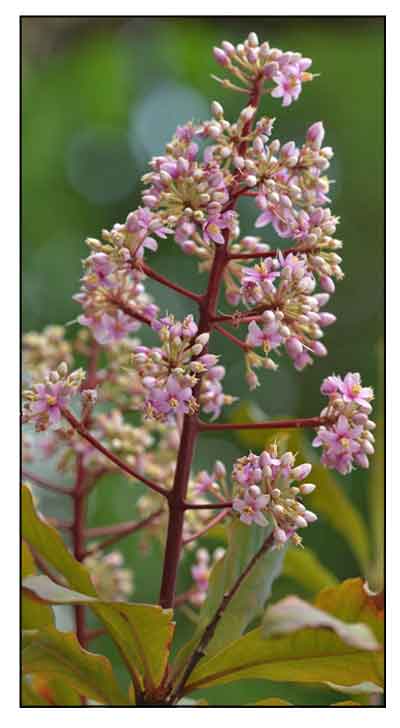
Family • Primulaceae
Aunasin
Payung-payung
Ardisia serrata (Cav.) Pers.
SAWTOOTH ARDISIA
| Scientific names | Common names |
| Anguillaria serrata Cav. | Aunasin (Tag.) |
| Ardisia abanii B.C.Stone | Payung-payung (Tag.) |
| Ardisia angustifolia A.DC. | Sawtooth ardisia (Engl.) |
| Ardisia candolleana Mez. | Serrated ardisia (Engl.) |
| Ardisia cavanillesii Roem. & Schult. | |
| Ardisia curtipes Merr. | |
| Ardisia dataensis Mez. | |
| Ardisia mindorensis Merr. | |
| Ardisia oligantha Elmer | |
| Ardisia oligocarpa Merr. | |
| Ardisia whitfordii Mez. | |
| Tinus candolleana Kuntze | |
| Tinus serrata (Cav.) Kuntze | |
| Ardisia serrata is an accepted species. KEW: Plants of the World Online | |
| Taxon conflict: Some compilations list Ardisia pyramidalis and A. serrata as synonyms. POWO and Co's Digital Flora of the Philippines list them as separate species. (•) "Species of Philippine Ardisia Sw" (Magtoto, Buot 2020) lists Ardisia serrata and A. pyramidalis as separate species. (6) | |
| Aunasin, as common name, is applied to both. | |
| Other vernacular names |
| Malay: Aunasin, Rugrusu. |
June 2024
![]()
 |
| PHOTOS / ILLUSTRATIONS |
| IMAGE SOURCE: Primulaceae : Ardisia serrata / Flowering and fruiting twigs / Copyright © 2015 by P B Pelser & J F Barcelona (contact: [email protected]) [ref. DOL94733] / Non-Commercial Use / Image modified / Click on image or link to go to source page / Phytoimages.siu.edu |
| OTHER IMAGE SOURCE: Ardisia serrata / Inflorescence / Cerlin Ng / CC BY-NC-ND / Click on image or link to go to source page / Useful Tropical Plants |
Additional
Sources and Suggested Readings |
• |
DOI: It is not uncommon for links on studies/sources to change. Copying and pasting the information on the search window or using the DOI (if available) will often redirect to the new link page. (Citing and Using a (DOI) Digital Object Identifier) |
| List of Understudied Philippine Medicinal Plants |
| New plant names needed The compilation now numbers over 1,300 medicinal plants. While I believe there are hundreds more that can be added to the collection, they are becoming more difficult to find. If you have a plant to suggest for inclusion, native or introduced, please email the info: scientific name (most helpful), local plant name (if known), any known folkloric medicinal use, and, if possible, a photo. Your help will be greatly appreciated. |
• |
 |



